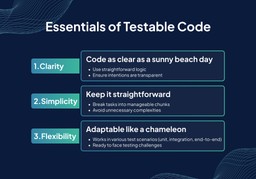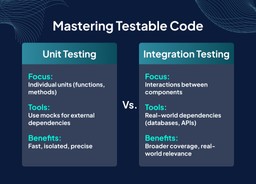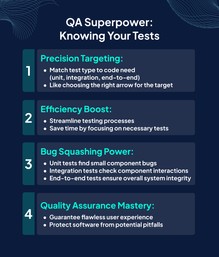Hey there, fellow QA aficionados!
Let’s journey into the fascinating realm of writing testable code.
Picture this: in February 2024, 52 thousand mobile apps landed on the Google Play Store.
That’s a whole lot of digital goodness flooding our screens.
But with great apps come great responsibilities, and QA professionals are crucial in ensuring their quality with proper coding!
Before we kick things off, let’s talk about leveling up your skills. Ever considered taking a QA course?
In this age, getting certified is vital in showing employers you mean serious business when applying for QA jobs. When testing code, you’ll be able to do the work more confidently and efficiently.
Now, grab your favorite beverage, cozy up, and unravel the secrets behind crafting code that’s functional and a breeze to test.
What is Meant by Testable Code?
Testable code is like crafting a well-built Lego masterpiece – it’s structured, modular, and easy to inspect.
It’s code that welcomes testing with open arms, making it a breeze to verify its correctness and resilience. How do we achieve this coding nirvana, you ask?
First off, clarity is essential!
We’re talking about code that’s as clear as a sunny day at the beach. By keeping our logic straightforward and our intentions transparent, we make it easy for humans and machines to understand what’s happening under the hood.
Next up, simplicity is our guiding star!
Testable code doesn’t need to be a labyrinth of complexity. By breaking down our tasks into manageable chunks and avoiding unnecessary convolutions, we pave the way for smoother testing journeys.
And let’s remember flexibility!
Testable code is like a chameleon – it adapts effortlessly to different testing scenarios. Whether we’re running unit tests, integration tests, or end-to-end tests, our code stands strong, ready to face whatever challenges come its way.
So, there you have it – testable code demystified! It’s all about clarity, simplicity, and flexibility wrapped up in a neat little package.
Why Knowing Your Test Types is a QA Superpower
Let’s talk about why understanding the different types of tests for code is like having a superpower in your QA toolkit.
Precision Targeting: Picture yourself as a sharpshooter aiming for the bullseye. Knowing the type of tests for your code is like choosing the perfect arrow for your target.
Are you testing individual components (unit test code), the interaction between them (integration tests), or the entire system (end-to-end tests)?
Each type of test has its role, and understanding them empowers you to hit the mark with precision.
Efficiency Boost
Time is precious, right?
By knowing the type of tests needed for your code, you can streamline your testing process like a well-oiled machine. No more wasting hours running unnecessary tests or missing critical ones.
You’ll be laser-focused, maximizing your efficiency and getting the job done in record time.
Bug Squashing Power
Bugs beware – with the right tests in your arsenal, you’re unstoppable! Different types of tests uncover different kinds of bugs.
Unit tests catch those pesky little critters hiding in individual components, while integration tests sniff out issues in the interaction between them. And let’s remember end-to-end tests, the ultimate bug busters that ensure your entire system works harmoniously together.
Quality Assurance Mastery
It’s all about ensuring the quality of your software. Knowing the type of tests for your code isn’t just about checking boxes – it’s about guaranteeing a flawless user experience.
By mastering test types, you become the guardian of quality, safeguarding your product against potential pitfalls and delivering excellence every step of the way.
Navigating the Nuances: Writing Testable Code for Unit Tests vs. Integration Tests
As QA experts, understanding these differences is key to mastering the art of testing effectively and efficiently.
Granularity vs. Interaction
- Unit Testing: Think of unit tests as magnifying glasses, zooming in on individual units of code in isolation. When writing unit tests, you’re testing the smallest building blocks of our application – functions, methods, or classes – to ensure they work as expected.
- Integration Tests: On the other hand, integration tests zoom out, focusing on the interaction between different components of our system. We’re not just testing individual units in isolation; we’re verifying that these units play nicely together when integrated into the larger system.
Mocking vs. Real-world Interaction
- Unit Tests: When you write unit tests, QAs often use mocks to simulate the behavior of external dependencies. By mocking these dependencies, we can isolate the unit under test and control its environment, ensuring predictable and reliable results.
- Integration Tests: In contrast, integration tests typically interact with real-world dependencies – databases, APIs, or other services. Here, we’re testing the actual integration points between our application and external systems, verifying that they function correctly in a real-world scenario.
Speed and Isolation
- Unit Tests: Due to their focus on small, isolated units of code, unit tests tend to be fast and lightweight. Since we’re not interacting with external systems, we can run hundreds or even thousands of unit tests in a matter of seconds, providing rapid feedback on the correctness of our code.
- Integration Tests: On the flip side, integration tests may be slower and more resource-intensive. Because they involve interactions with external dependencies, such as databases or APIs, they often require setup and teardown procedures, and their execution time may vary depending on the complexity of the system being tested.
Scope and Coverage
- Unit Tests: Unit tests offer fine-grained coverage of our codebase, focusing on individual units and their behavior. They excel at catching bugs at the smallest level of granularity, ensuring the reliability and correctness of our code.
- Integration Tests: Integration tests provide a broader scope of coverage, validating the end-to-end functionality of our system. They’re particularly valuable for testing interactions between different components and detecting issues that may arise when these components are integrated.
By understanding these nuances in writing testable code for unit tests and integration tests, we equip ourselves with the knowledge and skills needed to create comprehensive testing strategies.
Crafting Testable Code for Unit Tests: Your QA Blueprint
Alright, let’s roll up our sleeves and dive into the nitty-gritty of writing testable code specifically tailored for unit tests.
As a QA pro, mastering this skill is like having a secret weapon in your testing arsenal.
Modular Marvels
When writing code for unit tests, think modular! Let’s say we’re building a simple calculator app in Python. Instead of writing one giant function to handle all calculations, we break it down into smaller, independent units:
def add(a, b):
return a + b
def subtract(a, b):
return a – b
Each function performs a specific operation and can be tested independently, making our codebase more modular and easier to test.
Surgical Precision
Unit tests are all about precision targeting. Let’s write a unit test for our add function:
import unittest
class TestCalculator(unittest.TestCase):
def test_add(self):
result = add(3, 5)
self.assertEqual(result, 8)
if name == ‘__main__’:
unittest.main()
Here, we’re testing the add function in isolation, ensuring that it returns the correct result when given two numbers.
Mocking Magic
Sometimes, our code relies on external dependencies. Let’s say our calculator app needs to fetch exchange rates from an API to convert currencies. We can mock the API response in our unit tests:
from unittest.mock import patch
@patch(‘calculator.fetch_exchange_rate’)
def test_convert_currency(mock_fetch_exchange_rate):
mock_fetch_exchange_rate.return_value = 1.5 # Mock exchange rate
result = convert_currency(100, ‘USD’, ‘EUR’)
self.assertEqual(result, 150)
Here, we’re mocking the fetch_exchange_rate function to simulate its behavior during testing, allowing us to test the convert_currency function in isolation.
Readable and Reliable
Testable code isn’t just about passing tests – it’s about creating a foundation of code that’s readable, maintainable, and reliable. Let’s ensure the code is well-documented and follows best practices to enhance readability and maintainability.
# Function to calculate the area of a rectangle
def calculate_rectangle_area(length, width):
“””
Calculate the area of a rectangle.
:param length: The length of the rectangle.
:param width: The width of the rectangle.
:return: The area of the rectangle.
“””
return length * width
That’s all for unit tests, now let’s move on to integation tests!
Crafting Testable Code for Integration Tests: Your QA Blueprint
Just like with unit tests, mastering this skill is crucial for QA professionals seeking to ensure the reliability and robustness of their software.
Component Collaboration
- Modular Approach: Consider an e-commerce application. Instead of a single monolithic codebase, break down functionality into modules such as user authentication, product catalog, and payment processing. Each module should have clear responsibilities and interfaces.
- Clear Interfaces: Define clear APIs between these modules. For example, the product catalog module might expose APIs to retrieve product information, add items to a shopping cart, or update inventory levels. These interfaces should be well-documented and adhered to by collaborating components.
# Product Catalog Module
class ProductCatalog:
def get_product(self, product_id):
# Implementation to retrieve product information from the database
pass
def add_to_cart(self, product_id, quantity):
# Implementation to add items to the shopping cart
pass
Real-world Interaction
- Database Interactions: In integration tests, interact with a real database to simulate real-world scenarios. For example, when testing the checkout process, ensure that orders are correctly saved to the database and inventory levels are updated accordingly.
- API Calls: Similarly, interact with external APIs in a controlled environment. For instance, when testing payment processing, mock responses from a payment gateway API simulate successful and failed transactions.
# Integration Test for Checkout Process
class TestCheckoutProcess(unittest.TestCase):
def test_successful_checkout(self):
# Simulate adding items to the cart
product_catalog.add_to_cart(product_id=’123′, quantity=2)
# Simulate the checkout process
checkout_service.process_checkout()
# Verify that the order is saved to the database
self.assertTrue(order_database.check_order_saved())
Scenarios and Flows
- End-to-End Flows: Consider testing the entire user journey, from browsing products to completing a purchase. Write integration tests that simulate these user flows, including scenarios such as adding items to the cart, applying discounts, and entering shipping information.
- Data Flow and Communication: Verify that data flows correctly between different components. For instance, when testing the login process, ensure that user credentials are passed securely from the frontend to the backend and that authentication tokens are generated and validated correctly.
# Integration Test for User Authentication
class TestUserAuthentication(unittest.TestCase):
def test_successful_login(self):
# Simulate user login
response = auth_service.login(username=’test_user’, password=’password’)
# Verify that authentication token is generated
self.assertTrue(‘token’ in response)
Readability and Maintainability
- Documentation and Clarity: Document test scenarios and assumptions clearly in your test code. For example, include comments explaining the purpose of each test case and any preconditions required for its execution.
- Separation of Concerns: Keep test logic separate from production code to maintain clarity and avoid clutter. Use separate files or directories for test code, following naming conventions that distinguish it from production code.
# Integration Test Suite for E-Commerce Application
class TestECommerceIntegration(unittest.TestCase):
# Test setup code
def setUp(self):
# Initialize test data and dependencies
pass
# Test cases
def test_checkout_process(self):
# Simulate end-to-end checkout process
pass
def test_user_authentication(self):
# Simulate user authentication process
pass
By following these principles and best practices, you’ll be well-equipped to craft testable code tailored for integration tests.
6 Best Tips for Writing Testable Code for QAs
Let’s now close things off and discuss these tips for writing testable code to make your QA journey a breeze.
- Modularize Your Code: Break down your code into small, manageable modules or functions. By keeping each piece of functionality focused and self-contained, you make it easier to write tests that verify specific behaviors.
- Prioritize Clarity and Readability: Writing test code should be as clear as a sunny day. Use meaningful variable names, descriptive comments, and well-structured code to ensure your intentions are crystal clear to anyone reading your code – including your future self!
- Minimize Dependencies: Reduce dependencies between different parts of your code whenever possible. Minimizing dependencies decreases the likelihood of ripple effects when making changes and makes your code easier to test in isolation.
- Leverage Static Methods and Business Logic in JavaScript: Use static methods to encapsulate common functionalities that don’t rely on instance-specific data. Separate your business logic from your presentation layer in JavaScript, making it easier to test your application’s core functionality independently.
- Design with Testing in Mind: When designing your code, think about how you’ll test it. Consider factors like input validation, error handling, and edge cases from the outset. By designing with testing in mind, you’ll save yourself headaches down the road.
- Invest in Automation: Embrace the power of automation! Automated writing tests can run quickly and reliably to verify the correctness of your code. Whether it’s unit tests, integration tests, or end-to-end tests, automation is your best friend in the quest for high-quality software.
Your Path to QA Excellence with Syntax Technologies
In conclusion, if you want to write testable code with full-on mastery, it’s a very crucial skill for any QA professional.
By following best practices such as modularizing your code, prioritizing clarity, minimizing dependencies, designing with testing in mind, and investing in automation, you can confidently ensure your software’s reliability and robustness.
At Syntax Technologies, we understand the importance of equipping QA professionals with the skills they need to excel in their roles.
That’s why we offer a comprehensive QA course designed to cover all aspects of software testing, from writing testable code to executing automated tests.
With our expert-led training and hands-on exercises, you’ll gain the knowledge and practical experience needed to ace your QA certifications and propel your career to new heights.
Enroll now and take your QA skills to the next level!




